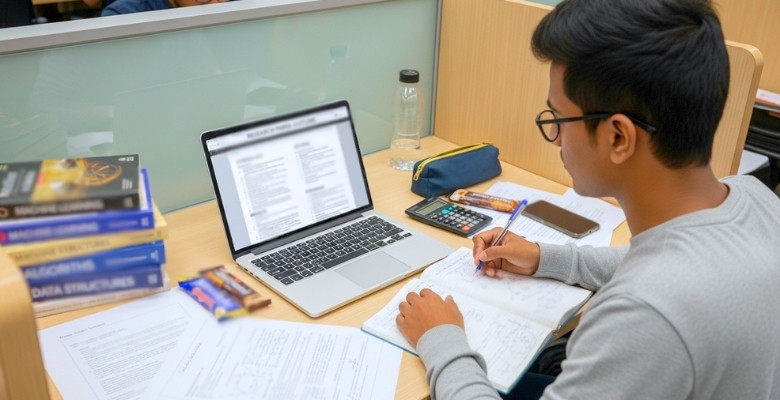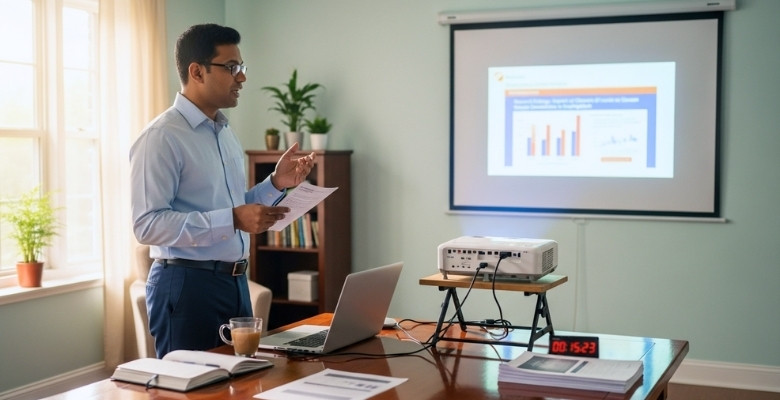Computer engineering conferences are exciting places where new technologies and innovative solutions are shared. If you’ve worked on something valuable and want others to recognize it, submitting a research paper can be a smart move to get noticed. Now you may wonder, how to submit a research paper to a computer engineering conference?
To submit a research paper, start by finding a conference that matches your topic. Carefully read the submission guidelines and follow them closely. Write your paper clearly, organize it well, and proofread thoroughly. Ask mentors or peers for feedback. Once ready, upload your paper to the conference’s official site before the deadline, then wait for the review outcome.
Are you wondering what happens after submission? Or maybe you’d like help finding the right conference for your work? Keep reading—this article walks you through every step so you can submit your paper with confidence.
How to Submit a Research Paper to a Computer Engineering Conference?
Whenever you’ve done something interesting in computer engineering and want others to know about it, sending your paper to a conference is a smart move. It might seem a little hard at first, but don’t worry. You don’t have to be a pro to make it happen. With a few easy steps and some planning, you can do it. Let’s see how to get started:
Pick the Right Conference
First, find a computer engineering conference that fits your topic. Some focus on hardware, others on software or systems. If you’re thinking about international events like conferences in USA, Germany, or other countries, make sure your topic fits what they want. Read the conference’s focus areas and check the deadlines and submission details on the official website.
Know the Rules
Each conference has its own rules for submitting papers. These include how long the paper should be, the format to use, and how to upload it. It’s important to follow these rules exactly. Otherwise, your paper might not be accepted. You’ll usually find these guidelines on the conference website. Read them fully before you start writing.
Write the Paper
Begin with a title and a short summary (called an abstract). Explain the challenge you worked on and how you approached it. Write clearly so others can understand your idea without confusion. Use simple language and short sentences. Diagrams, code snippets, or charts can help show your work more clearly—add them if they make things easier to follow.
Ask for Help
It’s perfectly okay to get help while writing your paper. Ask teachers, friends, or experts to review it. They can point out unclear parts, fix grammar, or suggest better ways to explain your ideas. You can also read papers from previous conferences to see what works well. Good feedback can really improve your paper.
Submit the Paper
Start by visiting the conference website and navigating to the submission page. Enter all required details like your name, paper title, abstract, and keywords, then upload your paper in the correct format. Review your information carefully before hitting submit. Keep the confirmation message as proof of submission.
Wait for Reply
Once your paper is submitted, a group of reviewers will read and evaluate it. This process takes time—usually a few weeks. Don’t worry if you don’t hear back right away. If your paper isn’t accepted, don’t feel bad—it happens. You can always improve it and try again. If it’s accepted, they’ll tell you what steps to take next.
Spread Your Work
If your paper is accepted, you might be invited to present it at the conference. This could be a talk or a visual presentation. It’s a great chance to share your work, meet others in the field, and learn from fellow researchers. Don’t be nervous—just enjoy the opportunity to show what you’ve done.
Why Should You Submit Your Research Paper to a Computer Engineering Conference?
Ever thought about showing your cool computer engineering idea to others? Sending your work to a conference might be the perfect way to do it. It may seem confusing at first, but it’s really not that hard. With a little effort, you can do something exciting and rewarding. Continue reading to learn why it’s worth doing.
Share Your Ideas
When you send your paper to a conference, you get a chance to tell others what you’ve done. People like to hear about new ideas, and your work could help them too. Even if your idea is simple, it can still be interesting. You never know who might find it useful. Sharing is the first step to making your work matter.
Get Helpful Feedback
Experts read your paper and sometimes give suggestions at a conference. This can help you see where your work is strong or where it can be better. You may not always notice small mistakes, but others can. Getting feedback like this can help you improve faster. It’s like having a smart friend who gives good advice.
Learn From Others
You won’t be the only one sharing ideas; there will be many others as well. You can read or listen to what they worked on and learn new things. It’s fun to see how people solve problems in different ways. You might even get ideas for your next project. It’s a great way to grow your knowledge.
Feel Proud of Your Work
Finishing a paper and sending it to a conference feels great. It shows that you worked hard and believed in your idea. Seeing your name on a paper or hearing people talk about your work feels special. It’s something you can be proud of. This feeling makes all the effort worth it.
Meet New People
Conferences are full of people who like the same things as you. You can meet new friends, talk about ideas, and ask questions. Some people might even want to work with you in the future. It’s a good place to make useful and fun connections. Talking to others can also give you more confidence.
Try Something New
Submitting a paper is a different kind of challenge. It teaches you how to explain your work clearly and follow some rules. It might be a little scary at first, but it’s a good kind of challenge. Trying new things helps you grow and learn. And once you try it, you might want to do it again.
How to Structure Your Computer Engineering Research Paper for Maximum Impact?
Writing a computer engineering paper might sound tricky at first, but don’t worry—it can actually be simple and fun. You just need to know what to include and where to put it. A good structure makes your paper easy to read. Want to learn how to do it? Then look below:
Catchy Title
Your title is the first thing people see, so make it clear and interesting. It should tell what your paper is about in just a few words. Try not to make it too long or confusing. A good title makes people want to read more. Think of it like a name that gives a quick idea of your work.
Short Summary
Right after the title, you need a small paragraph called a summary. It tells what your paper is about in just a few lines. Keep it simple and to the point. Use plain words so anyone can understand. This helps readers know what to expect in the paper.
Problem Statement
Now it’s time to explain the problem you worked on. What was not working well or needed to be fixed? Say it in a simple way so others can see why it matters. Don’t use too many big words—just explain what the problem is. This makes your paper stronger and more focused.
Your Idea
After you talk about the problem, share your idea to solve it. This is where you explain what you did. Tell how your idea works and why you think it’s a good one. Use easy words and give a few examples. If it helps, you can also describe it with steps.
How You Did It
This part is all about how you made your idea work. Did you use any tools, write code, or test things? Explain each step in order. Keep your sentences short and easy to follow. Try not to skip anything important. People should be able to understand what you did and how you did it.
What You Found
Now share what happened when you tried your idea. Did it work? Did something surprise you? Be honest and simple in your answer. Use small charts or pictures if they help explain things better. This shows others what you learned.
Final Thoughts
End your paper by sharing what you think about your work. Was it helpful? Could it be better in the future? Simple changes like clear writing and better structure can improve computer engineering research papers and make them easier to understand. Say what someone else could do next if they want to build on your idea. It’s a nice way to wrap everything up.
When Is the Right Time to Start Preparing Your Submission?
Getting ready to send your paper to a conference takes a bit of planning. You don’t want to rush or leave things to the last minute. Starting early makes everything less stressful and more fun. Want to know when and how to begin? Keep reading for some simple tips.
Know the Deadline
The first thing you should check is the deadline for submission. Most conferences post it on their website. If you don’t know the last date, you might end up in a rush. Write the date down or set a reminder. Knowing it early gives you enough time to plan everything well.
Plan Backwards
Once you know the deadline, work backwards to figure out when to start. Think about how much time you’ll need to write, check, and fix your paper. Also, give yourself time to ask someone to read it and share feedback. Starting a few weeks early is always better. This way, you won’t be rushing at the end.
Start With Notes
Before you even begin writing, start by collecting your thoughts. Write down your idea, problem, and how you solved it. Don’t worry about making it perfect right away. Just having notes helps you understand what to say later. These notes will make writing much easier when the time comes.
Check the Rules
Every conference has rules about how your paper should look. These rules tell you the format, length, and what to include. Read them early so you don’t have to change things later. If you follow the rules from the start, it saves time. You’ll feel more confident when you’re ready to submit.
Make Time to Review
Even after you finish writing, your paper still needs checking. You might find spelling mistakes or things that don’t make sense. It’s a good idea to read it more than once. You can also ask someone else to read it. Giving time for review makes your paper much better.
Issues to Avoid When Submitting a Computer Engineering Conference Research Paper
Submitting a research paper is exciting, but small mistakes can cause big problems. Many people face avoidable issues during the process. Here are common problems you should watch out for before sending your paper.
- Missing the Deadline: Waiting too long to start can lead to missed submission dates, which means your paper won’t even be reviewed.
- Ignoring the Guidelines: Each conference has its own format rules, and not following them can cause your paper to be instantly rejected.
- Weak Abstract Section: A confusing or unclear abstract might turn readers away, even if the rest of your paper is strong and useful.
- Unclear Problem Statement: If the problem you’re solving isn’t explained clearly, readers won’t understand why your research matters or what it solves.
- Too Much Jargon: Using hard words or too much tech-talk can make your paper difficult to follow, even for someone in the same field.
- Skipping Proofreading: Small grammar or spelling mistakes show a lack of care and can distract reviewers from your ideas or confuse your message.
- Forgetting to Cite Sources: Leaving out references to other work can make your paper look incomplete, or worse, like you’re copying someone else’s ideas.
- Not Testing the Idea: If your solution hasn’t been tried or explained well, readers won’t trust it or see how it really works.
Tips for Preparing a Conference Presentation After Your Research Paper is Accepted
It feels great to have your paper accepted, but now you must share it in front of others. That might feel a little scary. Don’t worry—you can make a great presentation with a little planning. Here is how to prepare a conference presentation after your research paper is accepted:
Know Your Topic
Start by reading your paper again from beginning to end. Make sure you understand every part, even the small details. If someone asks a question, you’ll be ready to answer. When you know your topic well, you feel more sure of yourself. This also helps you speak more naturally.
Make Simple Slides
Your slides should look clean and not too full of words. Use bullet points, short phrases, and pictures if they help explain better. Don’t try to put your whole paper on the screen. Keep it short so people can follow along easily. A good slide makes your talk stronger.
Practice Speaking
Read your talk out loud a few times before the real day. You can do it in front of a mirror or a friend. This helps you catch mistakes and speak more clearly. Practice also helps you feel less nervous. The more you practice, the smoother your talk will be.
Keep It Short
Most presentations have a time limit, so don’t make your talk too long. Focus on the main idea and key points. You don’t have to say every little thing from your paper. Just explain what matters most. This helps people stay interested from start to finish.
Be Ready for Questions
After your talk, someone might ask a question about your work. Don’t worry if you don’t know the answer right away. Just be honest and calm. If you do know the answer, explain it clearly and simply. It’s okay to say, “That’s a good question, I’ll look into it more.”
Look Decent
Wearing clean and neat clothes helps you feel more confident when you talk. You don’t need anything fancy—just simple and tidy clothes. For example, ideal clothing for Computer Engineering conference in the USA can be a plain shirt, nice pants, or a simple dress with clean shoes. When you look neat, people take you more seriously. Wearing something you feel good in makes it easier to stand and speak.
Stay Calm and Confident
It’s normal to feel a little nervous before talking in front of others. Take a deep breath and smile. Remember, people are there to learn from you, not to judge. Speak slowly and clearly, and look at your audience. Just enjoy sharing what you’ve worked on.
Frequently Asked Questions
After learning about the process of submitting your research paper, you might still have a few questions in mind. This section covers some common doubts and helpful tips that weren’t covered earlier. Keep reading to find answers that can make your submission even better.
What Is the Best Length for a Computer Engineering Conference Research Paper?
Most computer engineering conference research papers are between 6 to 10 pages long, but it depends on the conference rules. A good length gives you space to explain your idea clearly without making it too long or too short. Always check the official format before you begin writing.
Can I Submit the Same Paper to Multiple Conferences?
No, you should not submit the same paper to more than one conference at the same time. This is called “dual submission,” and most conferences do not allow it. If found, your paper can be removed from both events. Always wait for a decision first.
How Do I Choose Good Keywords for My Paper?
Pick words that match the main idea and important topics in your paper. Think about what someone would search if they wanted to find your work. Use 3 to 5 clear and simple keywords. Good keywords help the right readers find your paper faster.
What Format Should I Use to Write My Paper?
Most conferences accept papers in PDF format, written in specific templates like IEEE or ACM. You should download the official template from the conference website and follow it closely. This keeps all papers looking similar and makes it easier to read and review them.
What Happens If I Miss a Section in My Paper?
Missing important sections like abstract, conclusion, or references can hurt your paper. Reviewers might think it’s incomplete or rushed. Always check your paper from start to end and use a checklist before submitting. A complete paper has a better chance of being accepted.
Is It Okay to Use Online Images in My Paper?
Only use images you created or have permission to use. Don’t copy images from the internet without checking the rights. Use open-source images if needed and give credit where required. This keeps your paper honest and professional.
How Can I Make My Title Stand Out?
Use simple words that clearly say what your paper is about. A good title is short but meaningful. Don’t try to sound too fancy or complex. Think of what would make someone stop and want to read more.
What If I Realize a Mistake After Submission?
If the deadline hasn’t passed, some conferences allow resubmission or edits. If the portal is closed, email the conference team right away. Explain the mistake and ask if changes are possible. It’s always better to check than leave the error as it is.
Final Thoughts
A research paper deserves a clear path to the right computer engineering conference. Start by selecting a conference that aligns with your topic and goals. Check all the submission guidelines, including formatting rules, word limits, and important dates.
Learning how to submit a research paper to a computer engineering conference isn’t just about following steps—it’s about believing in your work and taking that first step forward. Whether your project is simple or detailed, your ideas matter and deserve a place on the stage.
So, start early, follow the rules, ask for help, and present your best work with confidence. You never know who will read your paper or where it might lead next.








